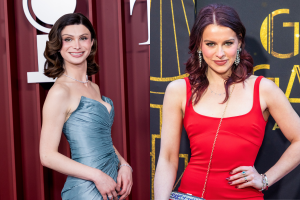Ferdy Roberts On … Filter-ing Shakespeare’s Dream
Award-winning Filter theatre company is known for its alternative and contemporary interpretations of classic texts. The
company’s current production, {A Midsummer Night’s
Dream::L02021454461}, is currently running at
the Lyric Hammersmith (until 17 March).
Here, Ferdy Roberts, one of Filter’s three artistic directors (along with Ollie Dimsdale and Tim Phillips), talks to Whatsonstage.com about the inspiration behind the acclaimed production, which is directed by Sean Holmes, and why Shakespeare continues to be relevant.
Ferdy
Roberts: We’ve worked with Sean Holmes quite a lot on classic texts, which is very different from the devised
work we create like Water,
Silence, and our first show
Faster. It’s an entirely different piece altogether,
obviously, because there’s a text. The way that we devise and create our
own work is with a lot of musical instruments and keyboards and
synthesisers, or what seems to be chaos in the room.
Years
ago, we did a workshop at the National studio playing around with an
idea that was potentially going to turn into a devised piece. At the end
of the three weeks, Sean suggested we play around with text just to see
what happens. He randomly chose Twelfth Night and after playing around
with it for two hours it sort of released some sort of anarchy and
freedom within the play itself. And then that obviously turned into a
show that we developed with the RSC and Sean, which attracted almost a
cult following.
Sean then came to us 18 months ago
with an idea to do another Shakespeare: A Midsummer
Night’s Dream. We didn’t really want to do it since it’s been
done so many times, but we thought that’s part of the reason to have a
look at it. So we originally created it for the Latitude Festival. We
used the same model as we did with Twelfth Night,
which is to challenge ourselves and see what we can put together in a
week from scratch. So all the sound and music and everything is written
in the room with the actors over the course of a week. Because of the
time pressure, it made us make bold and strong decisions very quickly
and stick with them.
We then revisited it last year
and looked at the stuff that didn’t work, but also created new
material. We then took out a tour at the end of last year and developed
it more and solidified the bold decisions we had made, of which there are
quite a few.
We knew we were going to do the tour and did a
week of development on it here at the Lyric. We performed it for one
night only for an invited audience just to get feedback and response,
which is vital to our work. The feedback was quite
extraordinary. A lot of people said for the first time it felt fresh to
them and felt like a new play, that it was the first time they were
really hearing the play as if it were written yesterday. When you only
have a week to put it in front of an audience, you don’t really know
what you’ve got. That’s the most exciting part of being with this ensemble, really. Everybody has to get together, stick together,
trust each other and basically have a bit of fun.
Working with sound and design
Use
of sound is always a trademark, or certainly something that we work with a lot; it allows us to fill in a lot of gaps. Fairies, for example, can be played
by musicians through manipulation of the voice. So using an eight-strong cast doesn’t
mean we’ve smashed the play to pieces, it’s just that with the use of
sound and sound design with composers and musicians we can play around creating different landscapes.
Tom Haines and
Chris Branch are both ridiculously clever, slightly geeky theatre
computer guys who write their own programs and create everything live on
stage every night. We’ve also got the band members acting in it, as
well. So the band members are the mechanicals, if you like. It seems to
work quite well, or it has been so far.
Because we knew about
performing at the Lyric, which is a big and beautiful theatre, we
wanted to focus it a lot more. If we’re playing with keyboards and a
couple of electric guitars, they can easily get lost in such a big
venue. It became quite difficult to reach and talk to the audience
directly without losing focus. So we decided that we’d approach the
Linbury Prize this year and work with a young designer (Hyemi Shin)
whose approach hasn’t necessarily been changed by the
industry yet.
Part of the reason we’ve always wanted to
work like that is because both Ollie Dimsdale and myself, who are
artistic directors with Tim, are actors. We’ve both worked outside of
Filter and know the normal way of designing a show is that a designer and a
director will go away and come up with a concept before day one and then they’ll go into the rehearsal room and present the idea.
You’re slightly going ‘all the decisions have been made, I just have to
work my way around getting involved in the concept.’ We didn’t want the
actors to impose something upon the nature of the process. We wanted
the process to start from day one with everybody in the room so
everybody feels like they have a shared responsibility for the end
product, which is quite unusual.
It’s kind of a new
thing for Filter, certainly with the classic text work, that we’ve
chosen to have a designer. We’ve worked with Jon Bausor before on
our devised work, but that process is with Jon in the room from the very
beginning. The designs of the shows sort of grew with the show itself
as it was being written and created, so the designs are very much part
of the world that we were discussing and exploring in the rehearsal
room. Whereas this time, we’ve got a designer that has seen a show that
exists and has to create a world that comes out of what we’ve already
created.
Hyemi saw the show and her first
response was that it didn’t need a design, which is why we went with
her because that’s actually a really good starting point. Sean and the
company worked with her and we’ve developed a design that is sort of a
playpen for the band and for us. Hyemi has sort of noted the energy
within the company and the group, which is playful and anarchic.
It’s a fun evening; we’ve discovered that people
have come away in fits of laughter and seem to be having a great time .
Shakespeare’s robustness
Before
we attacked Twelfth Night, I thought we should
leave him alone, bury Shakespeare for 20 years and create our own new
work. But when we started working on Twelfth Night,
we changed our views. There are
so many references from Shakespeare’s time that are still relevant
today. And his writing is so robust and malleable, it challenges people
in very exciting ways. The debates people have when they leave the
theatre are vital and hugely important.
I think maybe
we revere him too much. And we’re slightly scared of playing
with it and ripping it apart and digging deeper than ‘oh, his language
is really pretty and beautiful.’ What we wanted the actors to do was
speak as if it’s their own language. Make it their own, get to the heart
of it. And suddenly you find that these people are real.
With
the way we’ve been doing Shakespeare, we involve the audience a lot and
I think if we can surprise an audience they’ll think it’s the first
time they’ve heard this language. It’s not, obviously, but we’re not playing it in the sort of
classical, traditional way of speaking Shakespeare. It’s very robust,
it’s direct to the audience and takes you on a huge journey and doesn’t
really give you time to think. He moves you along very quickly and, what
I think is important is that he wasn’t writing for the academic world
at the time. It is believed that 95% of his audience would have been
illiterate. So his plays are entertaining as well, they are an
entertainment. They ought to be performed and witnessed and enjoyed,
which is why I think it is still relevant. They are just brilliant –
simple as that. They really are amazing plays and there’s always
something new in them to find.
– Ferdy Roberts was speaking to Andrew Girvan












